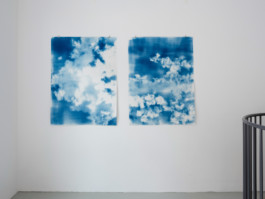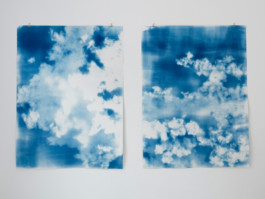

2021
Cyanotypie, Kontaktverfahren mit Watte
cyanotype, contact procedure with cotton
120 x 90 cm
Ausstellungsansicht
exhibition view
»What Cannot Be Seen», Akademie Galerie Nürnberg
Die Hintergründe der Produktion von fotografischen Bildern zu verstehen ist seit der Ankunft des Digitalen nicht einfacher geworden. Noch nie war das fotografische Bild so schnell „da“ wie mit den neuen digitalen Endgeräten (und man möchte hier von Errungenschaften sprechen). Zugleich hat sich der magische Moment der Umwandlung einer Lichtspur (des Realen) in ein fotografisches Abbild noch nie so sehr unserer Vorstellung entzogen wie heute – auch intellektuell erscheint er uns kaum mehr fassbar. Wie können wir (wieder?) zu einer Versprachlichung fotografischer Prozesse gelangen – um sie uns überhaupt vorstellbar zu machen? Denn muss dies nicht ein Projekt der Kunst sein: die Mittel der Gestaltung ergründen – und sie beherrschen? Zumindest kann man in Bezug auf die Fotografie sagen: Nichts ist so, wie es scheint. Dies ist ein Paradigma der Fotografie, das das Medium von Anfang an begleitet. Diesem Paradigma scheint Rebecca Schwarzmeier entgegentreten zu wollen, wenn sie mit alten oder historischen fotografischen Techniken arbeitet. Anders als in der Digitaltechnik kann man – wenn man möchte – in Schwarzmeiers Cyanotypien die Prozesse der Herstellung direkt am Objekt nachvollziehen. Es ist eine Offenlegung. Zugleich aber wählt die Künstlerin für ihre Bilder ein Sujet, dass sich einer Verstofflichung oder Konkretisierung geradezu entzieht: Wolkenformationen. Oder sind es überhaupt Wolkenformationen? Oder geraten die wolkenartigen Gebilde zu einer Parabel über das Fotografische schlechthin, nämlich der, dass das Medium (egal ob alt oder neu) nicht zu fassen ist?
Maren Lübbke-Tidow
Understanding the backgrounds of producing photographic images has not become easier since the arrival of digital technology. Never before has the photographic image been "there" so quickly as with the new digital devices (and one would like to speak of achievements here). At the same time, the magical moment of transforming a trail of light (of reality) into a photographic image has never been so elusive to our imagination as it is today - intellectually, it appears to us almost incomprehensible. How can we (re)achieve verbalization of photographic processes - in order to make them imaginable to us at all? Because doesn't this have to be a project of art: to fathom and master the means of design? At least in relation to photography, one can say: nothing is as it seems. This is a paradigm of photography that has accompanied the medium from the very beginning. Rebecca Schwarzmeier seems to want to counter this paradigm when she works with old or historical photographic techniques. Unlike in digital technology, in Schwarzmeier's cyanotypes, one can directly follow the production processes on the object if desired. It is a disclosure. At the same time, however, the artist chooses a subject for her images that is almost impossible to materialize or concretize: cloud formations. Or are they even cloud formations? Or do the cloud-like structures become a parable about photography itself, namely that the medium (whether old or new) cannot be grasped?
Maren Lübbke-Tidow


2021
Cyanotypie, Kontaktverfahren mit Watte
cyanotype, contact procedure with cotton
120 x 90 cm
Ausstellungsansicht
exhibition view
»What Cannot Be Seen», Akademie Galerie Nürnberg
Die Hintergründe der Produktion von fotografischen Bildern zu verstehen ist seit der Ankunft des Digitalen nicht einfacher geworden. Noch nie war das fotografische Bild so schnell „da“ wie mit den neuen digitalen Endgeräten (und man möchte hier von Errungenschaften sprechen). Zugleich hat sich der magische Moment der Umwandlung einer Lichtspur (des Realen) in ein fotografisches Abbild noch nie so sehr unserer Vorstellung entzogen wie heute – auch intellektuell erscheint er uns kaum mehr fassbar. Wie können wir (wieder?) zu einer Versprachlichung fotografischer Prozesse gelangen – um sie uns überhaupt vorstellbar zu machen? Denn muss dies nicht ein Projekt der Kunst sein: die Mittel der Gestaltung ergründen – und sie beherrschen? Zumindest kann man in Bezug auf die Fotografie sagen: Nichts ist so, wie es scheint. Dies ist ein Paradigma der Fotografie, das das Medium von Anfang an begleitet. Diesem Paradigma scheint Rebecca Schwarzmeier entgegentreten zu wollen, wenn sie mit alten oder historischen fotografischen Techniken arbeitet. Anders als in der Digitaltechnik kann man – wenn man möchte – in Schwarzmeiers Cyanotypien die Prozesse der Herstellung direkt am Objekt nachvollziehen. Es ist eine Offenlegung. Zugleich aber wählt die Künstlerin für ihre Bilder ein Sujet, dass sich einer Verstofflichung oder Konkretisierung geradezu entzieht: Wolkenformationen. Oder sind es überhaupt Wolkenformationen? Oder geraten die wolkenartigen Gebilde zu einer Parabel über das Fotografische schlechthin, nämlich der, dass das Medium (egal ob alt oder neu) nicht zu fassen ist?
Maren Lübbke-Tidow
Understanding the backgrounds of producing photographic images has not become easier since the arrival of digital technology. Never before has the photographic image been "there" so quickly as with the new digital devices (and one would like to speak of achievements here). At the same time, the magical moment of transforming a trail of light (of reality) into a photographic image has never been so elusive to our imagination as it is today - intellectually, it appears to us almost incomprehensible. How can we (re)achieve verbalization of photographic processes - in order to make them imaginable to us at all? Because doesn't this have to be a project of art: to fathom and master the means of design? At least in relation to photography, one can say: nothing is as it seems. This is a paradigm of photography that has accompanied the medium from the very beginning. Rebecca Schwarzmeier seems to want to counter this paradigm when she works with old or historical photographic techniques. Unlike in digital technology, in Schwarzmeier's cyanotypes, one can directly follow the production processes on the object if desired. It is a disclosure. At the same time, however, the artist chooses a subject for her images that is almost impossible to materialize or concretize: cloud formations. Or are they even cloud formations? Or do the cloud-like structures become a parable about photography itself, namely that the medium (whether old or new) cannot be grasped?
Maren Lübbke-Tidow